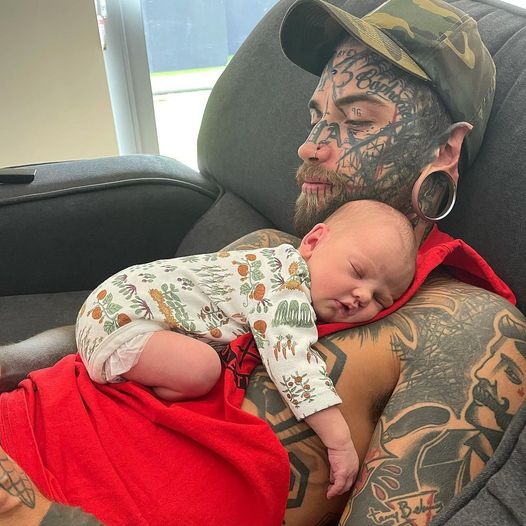At just 24 years old, he had already lived a lifetime. The ink that stretched across his skin wasn’t for show—it was a record of the years he fought to survive, to be seen, to feel in control of a world that had often felt like it was against him. Every tattoo told a story—of pain, of loss, of defiance, and sometimes, of desperation. His body was a journal, one that never needed to be opened to be read.
He had grown up without stability. Without guidance. Without softness. So, when life became too loud, the needle became his escape. The buzzing sound of the tattoo machine was, for years, the only thing that made the chaos go quiet. And he never thought he’d want to change that—until the day he became a father.
When he held his daughter for the first time, everything changed. Her skin was smooth, untouched by the world, untouched by pain. She looked up at him with wide, innocent eyes that didn’t see the past carved into his body—they only saw her daddy.
But as she grew, she began to notice. Her tiny fingers would trace the designs on his arms and ask questions he couldn’t bring himself to answer. “What does this one mean, Daddy?” “Why is there a skull?” “Why is this man angry?” Those moments pierced deeper than any tattoo needle ever could.
He realized that while his tattoos had been a form of survival, they were also a reminder of a life he no longer wanted to be tied to. He didn’t want his daughter to be afraid. He didn’t want her to think violence or pain was beautiful. He wanted her to know that people can change. That her father had changed. And so, he made a decision that would test every part of him.
He began the long, painful process of tattoo removal.
It wasn’t easy. Each session brought back the memories he had tried to bury. The laser stung, but not as much as the fear that maybe she would grow up seeing him as the man he used to be—not the father he was trying to become.
People asked him, “Why are you doing this? Those tattoos are part of you.”
His answer was simple: “Because I want to give my child a version of me that she can feel safe with. That she can look up to. That doesn’t carry the weight of things she’s too young to understand.”
He wasn’t ashamed of his past—but he didn’t want to pass it on. He knew that breaking the cycle meant making sacrifices. And for the first time, he had a reason to truly start over.
Months passed. Slowly, the ink faded. His skin, once marked with rage and sorrow, began to clear. It wasn’t perfect—but it didn’t need to be. It just needed to reflect who he was becoming.
The day his daughter wrapped her arms around him and said, “You look different, Daddy,” he smiled. Not because she noticed—but because she didn’t ask about the tattoos anymore. She didn’t see a man who had lived through darkness. She saw the man who tucks her in at night, who holds her hand when she’s scared, who reads her bedtime stories with voices and silly faces. She saw her hero.
This isn’t a story about a man removing ink.
It’s a story about a father rewriting his legacy.
Because sometimes love doesn’t just heal—it transforms.
And sometimes, the bravest thing a man can do is let go of the version of himself that once helped him survive… so he can become the version that helps someone else thrive.
